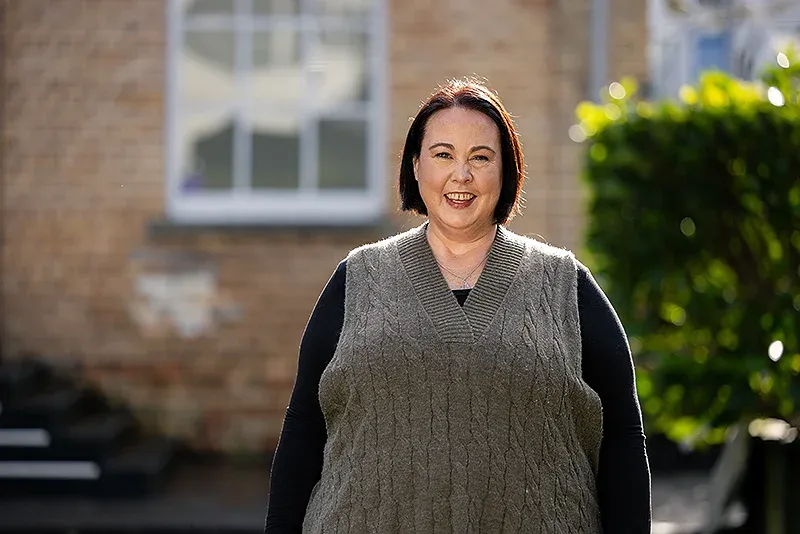The rapid rise of GLP-1 weight-loss drugs
By MAS Team
With GLP-1 weight-loss drugs now available in New Zealand, Kiwis across the country have, unsurprisingly, become increasingly curious about them. Health journalist Niki Bezzant delves into the pros and cons of these so-called miracle drugs, and how they could be used to help alleviate our obesity epidemic.
Melanie Dale lists all the ways she has tried to lose weight. “I did the keto diets. I did intermittent fasting. I did meal replacement shakes. I basically tried every diet,” she says. “And then I went to a dietitian and did the normal, healthy, well-balanced diets as well. I did all of those things, and nothing moved my weight in any significant way at all.”
The 49-year-old recalls the weight gain she experienced in her early 40s; the result, she says, of PTSD combined with perimenopause. “It didn’t matter what I did, the weight didn’t move more than a fluctuation of 5 kilos up or down.”
The weight made exercise difficult. “I had plantar fasciitis and all those body aches; it just made my life debilitating,” says the Auckland partnerships manager. “I remember thinking, ‘I don't want to live like this. I can't live like this. This is awful.’ I felt so ridiculously old before my time.”
As someone with a thyroid condition, Melanie was advised she wasn’t a candidate for bariatric surgery. But she was a good candidate for Saxenda, one of the new generation of drugs known as GLP-1 agonists that are changing the game for doctors and patients alike.

Melanie Dale who's on GLP-1 agonist Saxenda.
GLP-1 agonists are a class of drugs, including semaglutide, liraglutide, dulaglutide and exenatide, more commonly known by brand names such as Ozempic, Wegovy and Saxenda. They’re the blockbusters of the drug world, sitting among the top-10 selling drugs globally. Their reputation has been boosted by celebrities like Oprah Winfrey, and they’re suspected to be behind the dramatically slimmed bodies of many a Hollywood star. Around 13% of American adults have used one at some stage in their lives.
But the drugs are more than just a celebrity trend. First released in 2005 for the control of type 2 diabetes, these medications are considered by some experts to be the most significant addition to diabetes and obesity management in decades – or maybe ever.
As well as the original diabetes medications, there are now versions of the same drugs formulated specifically for weight loss. Wegovy, for example, is the weight-loss version of Ozempic, the most famous of the GLP-1s. The difference is in the dosage, with a higher dose needed for weight loss. Up until recently, the only weight-loss GLP-1 available in Aotearoa New Zealand was Saxenda, a first-generation GLP-1 taken as a daily injection, however, Wegovy was approved in April and is now available on prescription. GLP-1 agonists for type 2 diabetes, Trulicity and Victoza, are funded for diabetes patients who qualify, though supplies have been vulnerable to global shortages.
GLP-1 agonists work in several ways. They boost the action of a gut hormone called glucagon-like peptide-1 (GLP-1). The peptide is produced in the lower small intestine after eating, stimulating insulin release. It also reduces the counter hormone to insulin, glucagon, which positively impacts glucose metabolism.
The drugs also work on the brain, specifically the hypothalamus, the appetite and satiety centre. This signals the stomach to slow down emptying, making users feel full. The impact of this is one of the things users of the medications notice most: the quieting of what’s known as ‘food noise’.
Melanie describes this particular change for her as amazing. “I’ve never experienced more joy with food in my life,” she enthuses. “My desire to overeat and my craving for food has gone, so the enjoyment is just so much higher. In the past, I would’ve craved potato chips and I would’ve sat down and eaten a whole bag, just because there was no ‘off’ switch. Now, I'll have a handful of potato chips and really enjoy them, but there is no desire to carry on and there’s no real ability. I get to choose food that I really enjoy, enjoy a little bit of it and move on.”
That change, alongside a nutrition plan from a dietitian and an exercise regimen from a trainer, has resulted in a 23-kilogram weight loss in the space of 10 months. That’s in line with emerging evidence which shows typical weight loss of up to 15% of body weight for people using GLP-1s, similar to what happens with bariatric surgery.
GP and bariatric physician Lara Courtenay, a MAS Member who works with the Weightless specialist team at Auckland’s MacMurray Centre, says the dialling down of food noise gives people the space to explore the underlying issues of their obesity. She often recommends her patients also work with a psychologist.
She describes a patient who was visiting fast food drive-thrus so habitually, he did it on autopilot. “He would go to McDonald’s without even realising he’d done it. And [once on the GLP-1] he could actually stop and say, ‘I don't need this. I need to redirect myself.’ It’s quite interesting, and it’s very complicated.”

GP and bariatric physician Lara Courtenay, a MAS Member who works with the Weightless specialist team at MacMurray Centre.
Obesity is a problem researchers describe as wicked, meaning it’s complex, multifactorial and difficult to solve. In New Zealand, 1 in 3 adults has obesity, a rate which has been increasing for decades. Māori and Pacific people have even higher rates, and poverty is also a factor. Nearly half of the adults living in the most deprived neighbourhoods have obesity, compared to a quarter in the least deprived areas.
The causes of obesity are being refined by ongoing research. In January, The Lancet Diabetes & Endocrinology published a report proposing new ways of thinking about and caring for those with the condition, and for the first time classifying obesity as a disease in its own right. This reinforces the thinking that people with obesity do not simply have poor self-control; rather they are fighting their own biology and environments designed to make them unhealthy.
Kylie Russell is a dietitian at rfynd Weight Loss who works with patients on GLP-1 agonists. She’s noticed that the people she sees in her clinic have something in common. “Every person who presents has tried a multitude of diets. They are experts at diets, they could tell me the calories of everything as well as any dietitian could. They have really tried everything under the sun. People are exhausted from all the dieting.”
Kylie says people often interpret the failure of their diets as a personal failure. “I think there’s a real lack of understanding in terms of the complexity of obesity and how it works, and of our bodies and our biology. We are actually designed to resist weight loss from a biological perspective, and that’s where these medications are a real paradigm shift. It’s opening up that discussion; there’s a lot more going on than just diet and exercise here. Obesity is not a failure of willpower at all.”
GLP-1 agonists are not without side effects, and gastrointestinal issues are the most common. Users can experience nausea, vomiting, constipation and diarrhoea, especially as they work their way up to the recommended dosages. More serious, though rare, is the risk of gastroparesis (the stomach emptying too slowly or even stopping), vision issues and pancreatitis.
Another issue which can occur with any rapid weight loss is the loss of muscle mass. And because the appetite is so reduced, it’s important for people to focus on quality nutrition, or there’s a risk of undernutrition.
Kylie counsels clients starting on Saxenda that a quality diet is a key foundation. “I would have people on a higher protein diet than otherwise because we know protein requirements are higher. Muscle loss can be a problem if you’re not getting enough protein. A high-protein diet in this context needs to be combined with resistance training, so that you maintain that strength and function at the same time. Fibre is another really important one as well.”
Lara says she is upfront with her patients about this fact, but she does see people who are able to keep the weight off after stopping GLP-1 agonists.
“I tell people that when you lose weight, no matter how you lose weight, your body will try to regain it,” she says. “You actually have to eat 500 calories less a day, and exercise 30 minutes every day and control everything else. Only then will your body let the weight stay off. Maybe you will have to have a weight-loss shake for breakfast forever. And we have people doing it. I have people calling me 2 years after stopping, saying, ‘Lara, the weight's still off!’ It’s amazing.”
Lara believes the benefits of the medications far outweigh the risks. As well as weight loss, GLP-1 agonists have been shown to improve blood sugar, blood pressure and cholesterol levels. The US Food and Drug Administration (FDA) recently approved Wegovy as a treatment for heart disease and Ozempic as a treatment to reduce risks of chronic kidney disease.
And there’s a potential wider benefit to the health system, societies and economies in lowering the burden of obesity and associated conditions. According to Health Coalition Aotearoa, diet and excess body weight is responsible for 18% of premature death and disability in New Zealand.

GP and bariatric physician Lara Courtenay, a MAS Member who works with the Weightless specialist team at MacMurray Centre.
Because GLP-1 agonists are not funded in New Zealand for weight loss, there’s an obvious equity issue. The medications are expensive, with Saxenda costing about $500 a month. Only those with the means are able to access it; those in the most deprived communities, who are also at higher risk of obesity, are missing out.
“I feel terrible that people who really need it are not getting access,” says Lara. “It’s a huge ethical issue. It is only going to drive the inequalities further.”
Associate Health Minister David Seymour has indicated that he’s hopeful Pharmac might consider funding GLP-1s for obesity, considering the burden the disease places on the health system and economy.
In the meantime, users of the medications, like Melanie, will do whatever they can to self-fund and keep the benefits going. She is loving her new life.
“For me, the game changer is the fact that my body stopped aching, I could exercise freely and enjoy exercising, and I really started feeling good about myself. Not just because of the weight loss, but because I was able to move my body in a way that aligned with how I saw myself.”

Paddling their way down Whanganui River provided MAS Member Nicky Dewe’s family with stunning scenery, sore shoulders and some life lessons learned along the way.

Most of us wouldn’t head for a trip overseas without travel insurance, but what about domestic travel? If you have contents insurance with MAS, your stuff is most likely automatically covered under your policy if you’re on a domestic trip.

Emotional stress is felt throughout our body, it's not just limited to our over-worked mind. So what can you do to help someone who feels physical pain from an emotional event?